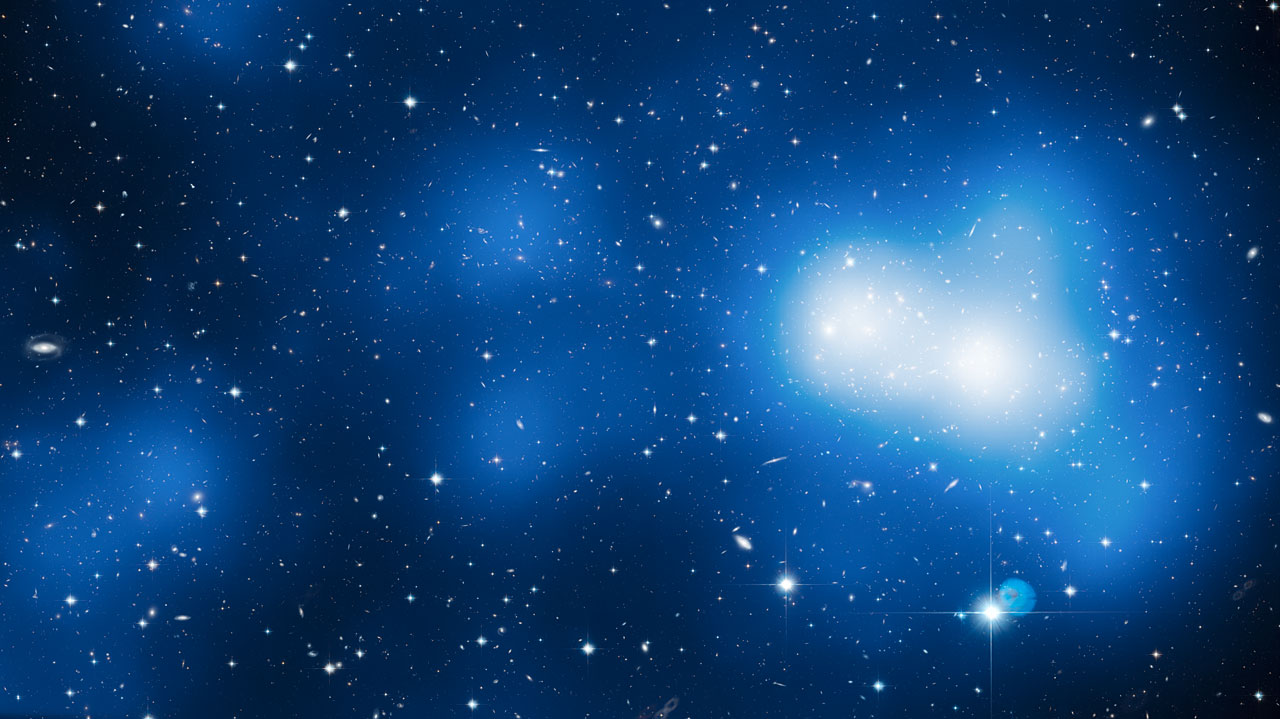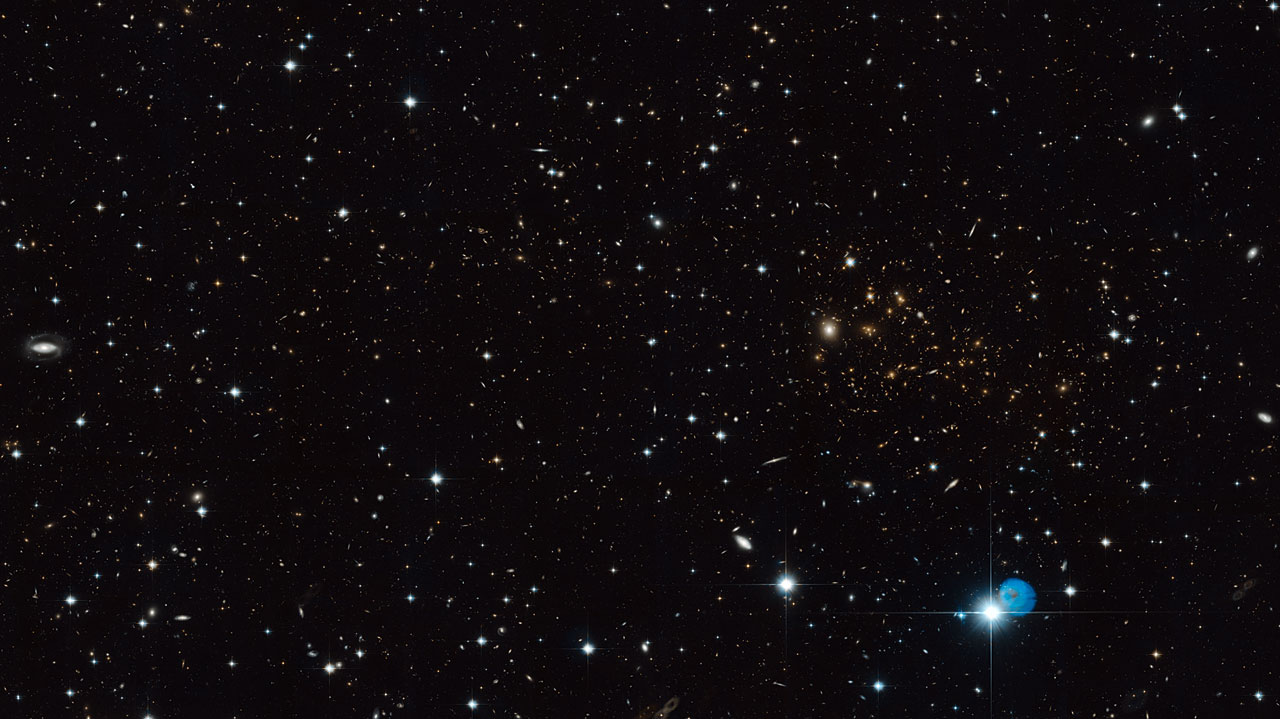ESA/HEIC Hubble Science Release | 2012 Oct 16
Astronomers using the NASA/ESA Hubble Space Telescope have studied a giant filament of dark matter in 3D for the first time. Extending 60 million light-years from one of the most massive galaxy clusters known, the filament is part of the cosmic web that constitutes the large-scale structure of the Universe, and is a leftover of the very first moments after the Big Bang. If the high mass measured for the filament is representative of the rest of the Universe, then these structures may contain more than half of all the mass in the Universe.MACS J0717 with mass overlay (NASA, ESA, Harald Ebeling
(University of Hawaii at Manoa) & Jean-Paul Kneib (LAM))Click to play embedded YouTube video.
The theory of the Big Bang predicts that variations in the density of matter in the very first moments of the Universe led the bulk of the matter in the cosmos to condense into a web of tangled filaments. This view is supported by computer simulations of cosmic evolution, which suggest that the Universe is structured like a web, with long filaments that connect to each other at the locations of massive galaxy clusters. However, these filaments, although vast, are made mainly of dark matter, which is incredibly difficult to observe.
The first convincing identification of a section of one of these filaments was made earlier this year. Now a team of astronomers has gone further by probing a filament’s structure in three dimensions. Seeing a filament in 3D eliminates many of the pitfalls that come from studying the flat image of such a structure.
“Filaments of the cosmic web are hugely extended and very diffuse, which makes them extremely difficult to detect, let alone study in 3D,” says Mathilde Jauzac (LAM, France and University of KwaZulu-Natal, South Africa), lead author of the study.
The team combined high resolution images of the region around the massive galaxy cluster MACS J0717.5+3745 (or MACS J0717 for short), taken using Hubble, NAOJ’s Subaru Telescope and the Canada-France-Hawaii Telescope, with spectroscopic data on the galaxies within it from the WM Keck Observatory and the Gemini Observatory. Analysing these observations together gives a complete view of the shape of the filament as it extends out from the galaxy cluster almost along our line of sight.
Mapping the Universe in 3-D
Institute for Astronomy | University of Hawaii | 2012 Oct 16
Combining observations from Mauna Kea with data taken by telescopes in space, astronomers at the Institute for Astronomy (University of Hawaii at Manoa) and their collaborators have developed a technique that allows them to map collisions of giant galaxy clusters in three dimensions.
Astronomers studying the solar system are fortunate. Their targets move, rotate, obscure, and deflect each other on timescales of hours, months, or years, allowing researchers to see them from different angles. Scientists exploring the distant universe are at a disadvantage in this regard. Most of their targets, such as black holes, galaxies, or clusters of galaxies, are so huge that it takes tens or hundreds of millions of years for an object to present us with a noticeably changed view.
“Being unable to see these large-scale structures from different angles makes it very difficult to figure out their three-dimensional shapes, let alone their relative motions and interactions,” explains Harald Ebeling, IfA astronomer and an expert on galaxy clusters. “All we see in our images is a 2-D projection of a 3-D structure onto the plane of the sky.”
Luckily, when two galaxy clusters collide, astronomers can make use of a clever combination of observations to make the invisible visible. In three recent studies, Ebeling and an international team of collaborators created 3-D models of merging galaxy clusters. Creating these models requires mapping all the components of a cluster: the galaxies that we see in visible light, the hot gas permeating the cluster that emits X-rays, and the invisible dark matter that can be detected only because its gravity distorts the images of objects behind the cluster. To collect all these data, Ebeling’s team used three world-class observatories: the Mauna Kea Observatories (specifically, the Keck I telescope of the W. M. Keck Observatory and the Canada-France-Hawaii Telescope), the Chandra X-ray Observatory, and the Hubble Space Telescope.
Combining the data to create a credible 3-D model of a complicated system like a merging cluster still involves a lot of physical interpretation. Admits Li-Yen Hsu, IfA graduate student and lead author of one of the three studies, “Our understanding of the shape and motion of the cluster kept evolving as we added more and more observational evidence. It’s a little like solving a jigsaw puzzle with half of the pieces missing.”
Eventually, enough pieces of the puzzle were collected to unravel, for instance, the geometry of MACSJ0717.5+3745, a giant triple merger of clusters fed by a filament of dark matter that extends 60 million light-years into space. The team was also able to measure the mass of the entire structure and found that filaments may contain more than half of the mass of the entire universe. Two other cluster mergers, examined in studies led by Hsu and fellow IfA graduate student I-Ting Ho, turned out to proceed along trajectories that are much more complex than suggested by the systems’ appearance in projection on the sky. By revealing these objects’ 3-D geometry, scientists can now correct for projection effects and determine the true properties of merging clusters.
Hubble Studies Dark Matter Filament in 3-D
Universe Today | Nancy Atkinson | 2012 Oct 16
A Weak-Lensing Mass Reconstruction of the Large-Scale Filament Feeding the Massive Galaxy Cluster MACS J0717.5+3745 - Mathilde Jauzac et al
- arXiv.org > astro-ph > arXiv:1208.4323 > 21 Aug 2012
- arXiv.org > astro-ph > arXiv:1207.6235 > 26 Jul 2012
- arXiv.org > astro-ph > arXiv:1209.2492 > 12 Sep 2012 (v1), 13 Sep 2012 (v2)


